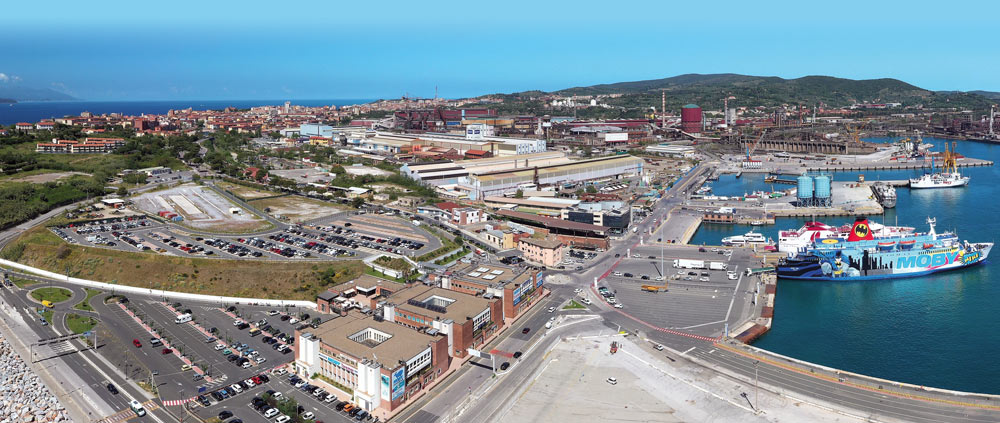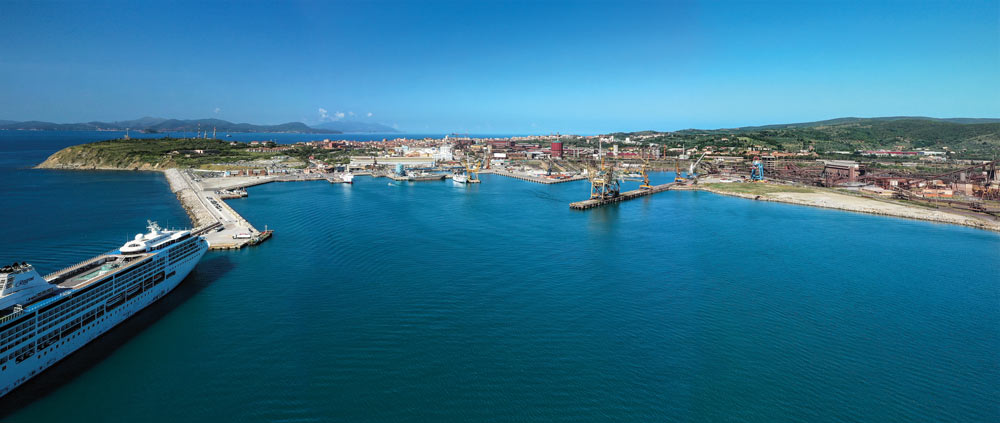The Port of Piombino
The Port of Piombino is located in the Val di Cornia/Alta Maremma area, along the southern Tuscan coast, between Livorno and Grosseto, at 42°55’ north latitude and 10°32’ east longitude. The Piombino area boasts an ancient industrial and port tradition. It looks out onto the islands of the Tuscan Archipelago and, at the same time, a hinterland with important historical sites such as Baratti/Populonia and the San Silvestro Archaeo-mineral Park.
Its multipurpose port is primarily dedicated to passenger/ commercial traffic to the islands (traditionally providing island links to Elba and, more recently, to Sardinia and Corsica, it plays a key role in guaranteeing territorial continuity) and to the bulk cargo traffic related to the steel sector.
The steel and iron trade dates back to 2.700 years ago, when the ancient Etruscan metropolis Pupluna (now known as Populonia), the only important Etruscan coastal city, led to the prosperity of this area by linking it to the iron, copper and silver deposits in the nearby Metalliferous Hills and Elba Island.
In the modern age, Piombino became the heart of the Italian iron and steel industry. Even today it can represent, together with other important centers such as Taranto and Terni, a strategic asset for developing the competitiveness of the Italian industrial system.
The port covers an area of about 350.000 m2 and offers approximately 4,6 km of quays with depths ranging from -6 to -20 m. Every year it handles 5 million tonnes of goods (solid bulk, Ro-Ro and Ro-Pax) and over 3 million passengers (ferries and cruise ships).
Also worthy of note are the shipbuilding activities in the new areas of the port currently under expansion developed by Piombino Industrie Marittime-PIM with the multipurpose platform for ship demolition, construction and refitting.
The Port in Numbers
Quays
Total Quay LenghtQuays
Allocated for passenger trafficINFRASTRUCTURE
Facility
For ferry passengers with about 30,000 m2 of parking spaceRailway station
for passengersGoods traffic is currently connected to the various industrial sites in the regional area by a railway service that runs along about 50km of specifically designated tracks 50km of specifically designated tracks

Technical- Nautical Servicies
Tugs
2 RINA-certified tugs with dual azimuth propulsion and firefighting capability (FiFi-1), ranging from 2,100 to 7,000 BhpVarious types of cranes

TOTAL QUAY LENGTH
Quays
Total Quays LengthQuays
Quays allocated for passenger trafficMacchine Operatrici
Rimorchiatori
Certificati RINA con doppia propulsione di tipo azimutale e capacità di antincendio (FiFi-1), con potenza da 2.100 a 7.000 BhpGru
di vario genereINFRASTRUTTURE
Stazione Marittima
Per traghetti con circa 30.000 mq di parcheggioScalo Ferroviario
Dedicato ai passeggeri.I traffici merci sono attualmente collegati ai vari siti industriali presenti sul territorio con assi ferroviari di penetrazione che si innestano su circa 50 Km di binari dedicati.
operators
The ports look to the future

Piombino’s Port Masterplan, approved in July 2013, defines the strategies for the new development of the port.
Subsequent planning documents and Institutional Agreements (D. L. n. 43 / 2013 and APQ 2014), aimed at coping with the industrial crisis hitting the leading steel plants in the area, have led to relaunching the port of Piombino and the infrastructures connecting it, both economically and in terms of production, thanks to the new port potential and the opportunities arising from an area with a vocation for large-scale industry, which can be reorganized, modernized, converted and diversified.
The new projects foresee the building of new port quays with areas and berths allocated for ship demolition and refitting, industrial logistics, a bulk terminal for the commodity hinterland, a steel products terminal, a public port with state-owned hinterland areas and logistics areas etc.
Environmental projects include the construction of the North dock and associated dockyard, as well as setting up an industrial logistics area.
Despite being two very different projects, both are in line with Piombino port’s area of specialisation, and follow a systemic rationale, in particular, regarding the port of Livorno.
